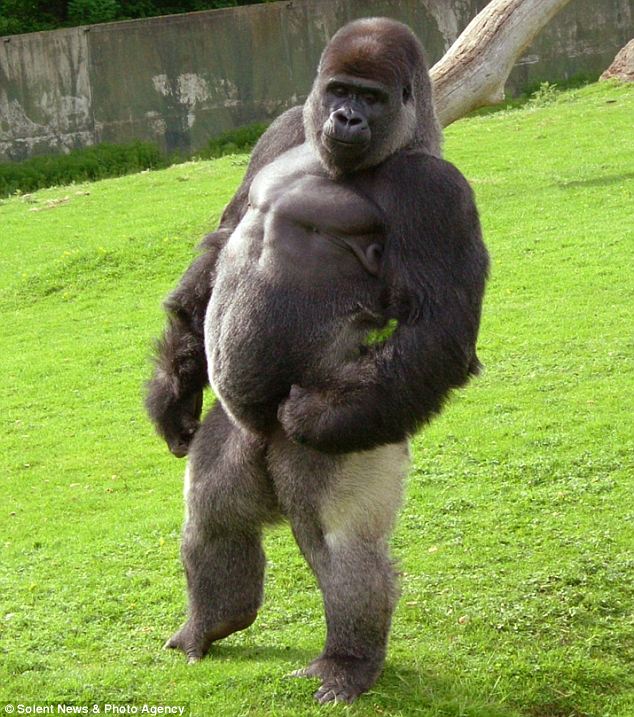
Compared to other primates, gorillas are generally quiet. They use vocalizations, visual signals, and scents to communicate. The females and youngsters will build comfortable nests of leaves and branches, while the silverback will settle in at the foot of the tree to protect his family. Gorillas sleep in trees, usually a different one each night. The group may have several younger “blackback” males, and twice as many females as males. The silverback, the leader of the group, is more of a benevolent dictator, and his authority is rarely challenged. Active during the day, gorillas spend most of their time foraging for food. They live in family groups, called troops, of 5 to 30 individuals, with an average group size of about 11. Social Behaviorĭespite their great size, gorillas are usually shy and passive animals. At the Zoo, their diet consists of much of the same food items such as fruit, vegetables, and leaves. They play an important role in maintaining the health and diversity of forests by dispersing seeds in their feces. In the wild, gorillas feed on fruit, roots, leaves, grasses, and insects. They are limited to small areas in Nigeria, Gabon, Equatorial Guinea, the Republic of Congo, Cameroon, and the Central African Republic. The lowland gorilla is found primarily in lowland tropical forests, particularly where there is dense ground-level vegetation, and in swamp forests. Lifespan is about 35 – 40 years in the wild and up to 54 years in captivity. Their hands and feet are broad and strong, and they move about on all fours in a “knuckle-walk.” Gorillas and chimpanzees are the only animals to use the backs of their fingers like feet. Gorilla faces are bare, with a short muzzle, large nostrils, and small eyes and ears that lie close to the head. Lowland gorillas have fine brownish-black fur and often a reddish crown. These males also have a more distinct ridge above the eyes, larger canine teeth, and a large cone-shaped skull. Mature males, called silverbacks, have a silvery white saddle that appears around 12 – 14 years of age. This species shows a great degree of sexual dimorphism. They have muscular, stocky bodies and can weigh up to 400 pounds. Gorillas are the largest of the great apes they stand up to six feet tall with an arm span of eight feet. Dominant males have been known to care for orphaned young within the troop.Each gorilla has a unique nose print, just like humans have different fingerprints.Gorillas make separate nests for daytime use and night-time use.The closest relatives of gorillas are chimpanzees and humans, all of whom diverged from a common ancestor about 7 million years ago.The Zoo has one adult male silverback and four female western lowland gorillas. Such analyses complement studies of the skeleton and contribute to our understanding of human evolution and adaptation.You can find the gorillas at the Jones Family Gorilla Preserve, a naturalistic exhibit featuring climbing rocks, tall trees and grass. For example, compared to highly dimorphic orangutans, gorillas have more muscle, less adipose tissue, lighter forelimbs and heavier hindlimbs. Data on the variation in tissue composition and body proportions in gorillas provide a basis for comparison with other hominoids, including humans. 37.3%), and twice the body fat (44%) forelimbs and upper body musculature were relatively well-developed to compensate for the restricted hip-joint movement due to arthritis. The old, obese female had one half the muscle tissue of the other three animals (16% vs.


This study found sex differences mostly in the upper body males have relatively heavier forelimbs, including heavier deltoid, trunk-binding, and deep back muscles compared to the younger female. Although gorillas are considered extremely sexually dimorphic in body weight and canine size, differences in tissue are not as dramatic as body mass differences suggest. Differences in age, sex, and life history events partially explain the observed variation in body proportions and tissue composition among the four animals.

Maximum estimates of body fat range between 19.4-44%. In tissue composition, three animals have on average 37.3% muscle relative to body mass.

The relative contribution of bone varies little among the four animals (10.2-13.4%) despite considerable range in body weights (99.5-211 kg). Body proportions and tissue composition (e.g., relative contributions of muscle, skin, bone, and adipose to total body mass) were determined through dissection of four adult captive lowland gorillas.


 0 kommentar(er)
0 kommentar(er)
